
This is a list of the National Register of Historic Places listings in Hamilton County, Ohio.

The Martin House is a historic residence in the Mount Washington neighborhood of Cincinnati, Ohio, United States. Built in 1847, the house is composed of two pieces: the original section, located in the back; and the front, built in 1852. Between the two components, it features elements of the Greek Revival and Federal architectural styles. Built of brick, two stories tall, it was originally a farmhouse belonging to John C. Martin, who built his home on property owned by his father-in-law Ezekiel Rigdon, who owned nearly 100 acres (40 ha) of land on Mount Washington near the farm of one of the area's first settlers.

The Henry P. Deuscher House is a historic farmhouse in the countryside of the southwestern part of the U.S. state of Ohio. Located near the city of Trenton, it was originally home to one of the area's leading farmers, and it has been named a historic site.

Hunting Lodge Farm is a historic house located near Oxford in Oxford Township, Butler County, Ohio, United States. Constructed as a hunting lodge, it has been used by multiple prominent local residents, and its distinctive architecture has made it worthy of designation as a historic site.

Christian Iutzi Farm is a historic property near Trenton, Ohio.
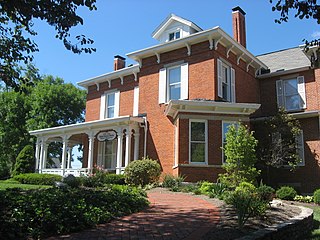
The Henry Maltby House was a historic house near the campus of Miami University in Oxford, Ohio, United States. Built in the 1850s, it was once home to a prominent minister in the community. Important partly for its architecture, it was eventually relegated to student housing before being demolished. Before its destruction, it was named a historic site.

Shaw Farm is a registered historic building near Ross, Ohio, listed in the National Register on 1974-07-24.

The Arledge Mounds are a pair of Native American mounds in the south central part of the U.S. state of Ohio. Located near Circleville in Pickaway County, the two mounds lie in the middle of a farm field, far from any roads. These two mounds are disparate in size: while the smaller mound's height is 5 feet (1.5 m), the other's is 20 feet (6.1 m), and their diameters are approximately 65 feet (20 m) and 120 feet (37 m) respectively.

The Armstrong Farm, also known as the Reber Farm, is a historic farm complex near Upper Sandusky in Crane Township, Wyandot County, Ohio, United States. Known for its association with Thomas V. Reber, a longtime president of the Wyandot County Agricultural Society, it was built in 1830.

The Arnold Homestead is a historic homestead in the city of Huber Heights, a suburb of Dayton, Ohio, United States. Formed at the turn of the nineteenth century, it centers on an 1830s farmhouse that was built for an immigrant family from Virginia.

The Martin Marmon House is a historic house near the village of Zanesfield in Jefferson Township, Logan County, Ohio, United States. Built by pioneer settler Martin Marmon around the year 1820, it is one of the best remaining examples of Quaker architecture in the area.
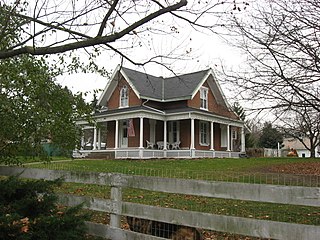
The Fulton Farm, also known as "River Bend Farm," is a historic farmstead in Shelby County, Ohio, United States. Located on the southern side of the city of Sidney, the farm is composed of five buildings spread out over an area of approximately 2 acres (0.81 ha). Built primarily in 1848, the distinctively Gothic Revival farm buildings are a leading element of Shelby County rural architecture; few pre-Civil War farmhouses elsewhere in the county are more elaborate. Besides the farmhouse, the complex includes four less important buildings, two brick and two wooden: a smokehouse, a carriage house, and two smaller barns.

The Jackson Mound is a Native American mound in the south-central portion of the U.S. state of Ohio. Located north of Pancoastburg in Fayette County, it measures approximately 75 feet (23 m) in diameter and 5.5 feet (1.7 m) in height. The mound has never been excavated, making the certain identification of its builders impossible; however, its location on a high terrace above a relatively small stream suggests that it was built by the Adena culture, which favored such sites for its many mounds. If true, it was originally more conical in shape, and it is likely to cover the remains of a wooden charnel house built by the Adena.
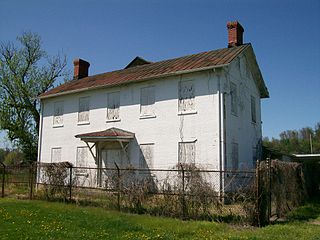
The Judge Joseph Barker House is a historic residence in southern Washington County, Ohio, United States. Located along State Route 7 southwest of the community of Newport, it is a brick structure with a roof of metal, a foundation of sandstone, and other elements of wood and metal. Constructed in 1832, it is a two-story rectangular building that sits atop an Ohio River bluff. Its floor plan is five bays wide, featuring a central entrance with a fanlight and sidelights.

The Jonathan Sprague House is a historic residence in northwestern Washington County, Ohio, United States. Located atop a bluff above the Muskingum River, it is one of Washington County's most significant houses, due to its age and method of construction.
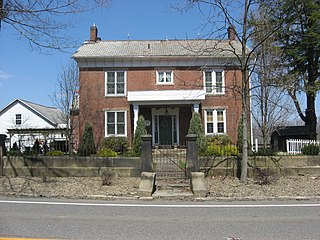
The Hiram Bell Farmstead was built by Hiram Bell in 1850. It is located in Fairfield Township, Columbiana County, Ohio. The house and adjoining buildings were added to the National Register of Historic Places as a historic district in 1999.

Redlands is a historic farmhouse near the city of Circleville in the south-central part of the U.S. state of Ohio. A grand home built in the middle of the 19th century, it has been named a historic site.

The Perrill–Goodman Farmhouse is a historic farmhouse in the central part of the U.S. state of Ohio. Located south of Groveport in Pickaway County, it has been named a historic site.

The Marquart-Mercer Farm in Clark County, Ohio, southwest of Springfield, Ohio, is listed on the U.S. National Register of Historic Places.
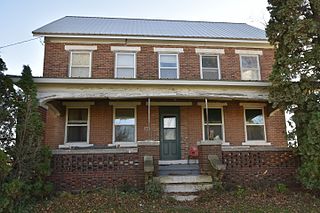
The Lamm-Pollmiller Farmstead District is a nationally recognized historic district located southeast of Salem, Iowa, United States. It comprises the farm house and outbuildings that were built by Henry and Elizabeth (Cook) Lamm beginning in 1849. The Lamms were Quakers who settled here from Ohio. The house is a two-story, brick, Greek Revival. The farm is located along the old Military Road that passed along the north side of the property. Local lore said that this was a stage coach stop in the 1850s and the 1860s. The Pollmiller family bought the farm in 1905. The farmstead was listed on the National Register of Historic Places in 2010.





















